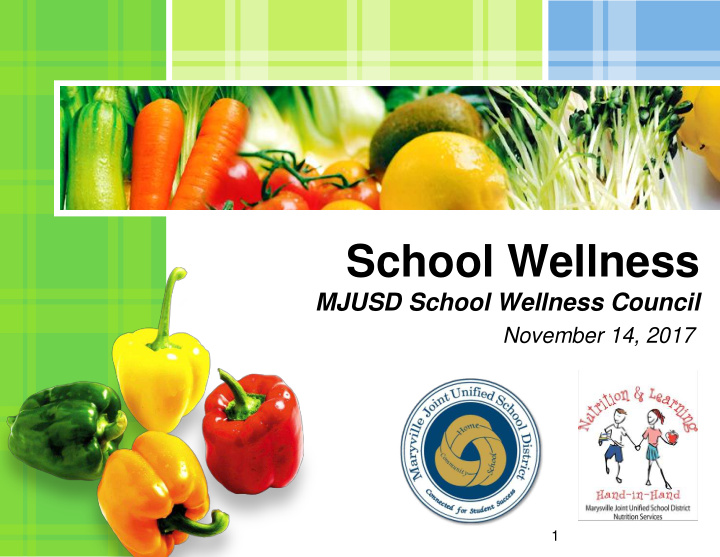



School Wellness MJUSD School Wellness Council November 14, 2017 1
Wellness at the Federal Level • Healthy Hunger-Free Kids Act of 2010 Public Law 111-296 enacted Dec 2010; Section 204 - Local School Wellness Policy • Requires districts that participate in the National School Lunch Program to establish a local wellness policy and inform the public • Required to measure and evaluate wellness policy compliance of current district practices with model policies • Each school must have a designee to oversee wellness policy • Nutrition guidelines limit calories, fat, sugar, and sodium 2
Committee Introductions • Amber Watson, RD, SNS, Director Nutrition Services • Jeri Echols Nutrition Site Manager III, Marysville High School • Michelle Hendrix Teacher, Marysville High School • Pierce Desmond ASB President, Marysville High School • Chelsey Slattery, MS Nutrition, Family & Consumer Sciences Advisor, Cooperative Extension 3
Wellness Policy Annual Evaluation • School compliance with the Wellness Policy assessed based on a series of questions addressing each domain: • Physical Education, Nutrition Education, School Activities • Nutrition • Staff, Community, Parent, and Volunteer Improvement • Students, Organizations, ASB • Health Services • Scoring Scale for Responses: 0 = Needs Improvement 1 = Meets Expectations 2 = Exceeds Expectations 4
Physical Education/Nutrition Education/School-Based Activities POLICY HIGHLIGHTS BP 5030 pp 2-3; AR 5030 pp 1-2 • Physical Education • Grades 1-6: 200 minutes every 10 school days • Grades 7-12: 400 minutes every 10 school days California Ed Code 51210/51222 (BR/AR 6142.7) • Nutrition Education • Provided through health education program K-12 • Integrated into core academic subjects • School-Based Activities • Encourage physical activity and formation of healthy eating habits before/after school. 5
Physical Education/Nutrition Education/School Based Activities WHERE WE ARE & WHAT WE HAVE LEARNED Intermediate/ Elementary-7 High-6.4 Intermediate/ Elementary-7 High -7.5 • Best Practices • Physical Education/Activity – Meeting or exceeding the required number of PE minutes • Nutrition Education – Utilize Harvest of the Month and Dairy Council Curriculum, STARS & UC CalFresh partnership 6
Nutrition POLICY HIGHLIGHTS BP 5030 pp 3-4; AR 5030 pp 2-3 • Nutrition Services • Cafeteria staff are well prepared & efficiently serve meals • Adherence to federal regulations regarding food/beverages • Food and Nutrition Standards • All foods and beverages sold on campus from midnight to one half hour after school day must: 1. Comply with USDA Smart Snacks in Schools and California Ed Code 2. Health Department approved source (not homemade) • Staff/parents are encouraged to support District Policy regarding food/beverages donated for classroom celebrations. 1. One non-compliant food/beverage permitted per party 2. Recommended celebrations occur after lunch 7
Nutrition Services WHERE WE ARE & WHAT WE HAVE LEARNED Intermediate/ Elementary-12.6 High-11.6 Intermediate/ Elementary-13.4 High-12.5 • Best Practices • Increased “speed scratch” menu items • Fresh fruits & vegetables offered • Weekly analysis of menus • Fresh ice water provided during all meal services • Approved list of foods to sell • Training provided for NS staff on variety of job-related topics 8
Staff, Community, Parent & Volunteer Involvement POLICY HIGHLIGHTS BP 5030 pp 3-4; AR 5030 pp 2-3 • Teachers/Staff model healthy behaviors • Parent/volunteer group at schools promote health and wellness by incorporating physical activity into programs, fundraisers, or other events • Food and beverages sold or served on campus meet USDA Smart Snacks & California Ed Code Regulations • Classroom Celebrations: 1. Nutrition quality considered when donating food/beverages 2. Celebrations occur after lunch 9
Staff, Community, Parent & Volunteer Involvement WHERE WE ARE & WHAT WE HAVE LEARNED Intermediate/ Elementary-8 High-6 Intermediate/ Elementary-9.7 High-6 • Best Practices • Class parties are scheduled at the end of the school day • Family events are planned (i.e. walk in local parades, sold local mandarins as school fundraiser) • Integrate healthy lifestyle into academic lesson plans • Publish parent newsletters with health messages • Food sold meets/exceeds the nutrition requirements • Include wellness/healthier options for reward recognition 10
Students, Organizations, and ASB POLICY HIGHLIGHTS BP 5030 pp 3-4; AR 5030 pp 2-3 • Safety On Campus • Promotes drug- and substance-free environment • Anti-bullying policies • Promotion of a healthy lifestyle • Food Sales (during school hours) • Food safety & sanitation standard requirements • Sales occur after lunch and do not compete with school nutrition program • Elementary Sales - one item per sale; four sales per school year • Intermediate/High Sales – no more than 3 categories of food items per sale, one organization sale per day, four “Food Days” per year 11
Students, Organizations, and ASB WHERE WE ARE & WHAT WE HAVE LEARNED Elementary-9.3 Intermediate/ High-9.8 Intermediate/ Elementary-10.7 High-8.75 • Best Practices • Safety on Campus • Implementation of Cyber Safety, PBIS, PASS Officer, Catapult • “Drug Free Zone”, Red Ribbon Week Celebration, Plant the Promise, 20 Days of Kindness Challenge, Character Chronicles • Food Sales (during school hours) • Monitoring food based fundraisers during school hours. • All schools scored themselves as meets expectations or higher for food sales during school hours. 12
Health Services POLICY HIGHLIGHTS BP 5030 pp 1-3; AR 5030 pp 1-2 • District Nurses educate Health Services and school sites on communicable disease control policies • Assistance with nutrition, respiratory management, disease prevention/detection, tobacco cessation and emotional wellness • Assist with non-mandated health screenings • Serve as a source of information on low/no cost health care resources and health insurance • Community outreach activities 13
Health Services WHERE WE ARE & WHAT WE HAVE LEARNED Elementary & Intermediate/High-7 Elementary & • Best Practices Intermediate/High-11 • Held Diabetic Health Fair • Collaborates with Yuba County Public Health, California Children’s Services • Participates in annual Nutrition Fair • Performs screenings, provides referral resources 14
Highlights 15
Highlights 16
Highlights 17
Highlights 18
Highlights 19
Committee Next Steps 2017-18 Goals • Teacher Academies: Nutrition Education focused • Seeking grants to purchase and install water stations • Improve communication on foods approved for schools to sell during the school day 20
Thank You! Questions? 21
Recommend
More recommend